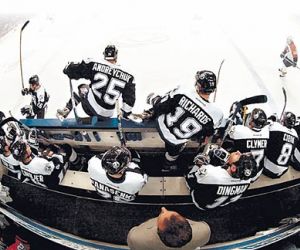Over The Boards

“We might get to see some surgery tonight.” I point at the suture kit on the hip of the trainer on the other side of the plexi-glass and raise an eyebrow at Colin. Sitting right behind the Wichita Thunder bench at the iWireless Center, the pre-game circus is in progress. It’s choreographed, loud and theatrically ominous. Sort of like how Brian Williams remembers helicopter flights.
A Williams Intermediate choir sings the national anthem. The cheery, pre-pubescent pitch is as incongruous with the “Let’s Get Ready To Rrrruuuummmmbbbbbllllle” vibe as Michael Moore at sniper school. Colin points out the medical snips hanging from the trainer’s belt loop don’t seem to be used much for haircuts, or beard trimming. The Thunder players appear universally late teens early twenties, and burly from birth. It’s a hockey player thing.
The trainer throws smelling salts down the bench like rice at a wedding and the second and third lines all take a hit, snapping their heads clear for the fight ahead. It’s axiomatic that the game – any game – looks easier from the stands than it does on the field but hockey (and fencing) makes the case. The game is brutally fast, and chillingly precise. They make a $550 a week living on finely honed edges, and hope the dentistry plan gets better at the next rung of the career ladder.
If you’ve never played, it is difficult to watch on television because the puck is a blur, rarely at rest. One secret to the game is the players don’t spend much time looking at the puck themselves. They can’t. There’s a direct correlation to looking down at the puck and having your head taken off. You skate to where the puck will be and hope it gets there on time. The rest is feel. The speed of the ice tonight. The sense of where your linemates are. The knurled edge of the puck on your meticulously taped stick.
You jump over the boards and go flat out for forty-five to sixty seconds. If that doesn’t seem long, go sprint for a minute and come back to the story. The conventional view is five guys are trying to beat six guys (including the goalie) to maneuver a three-inch diameter chunk of rubber into a net. That’s the view from the seats behind us, and television. The view up close … is art.
As one shift comes back to the bench, the next shift tumbles over the boards into the maelstrom. The contest doesn’t miss a beat as reinforcements are swapped in and out on the fly. There are instant looks passed between the incoming and outgoing players that describe the current state of the game and their personal commitment to each other to affect its outcome. The coaches watch for anomalies and issue curt instructions. The trainer patches up the wounded in the two to three minutes he has before the shift goes back over the boards.
The attack and counter-attack of hockey at full tilt is a Jackson Pollock masterwork, every twenty minutes. The goals are recorded for posterity, the skate tracks are Zambonied over, and the birthday kids with their cheese pretzels are missing much of it, but the art is there for anyone to appreciate. Seventeen have traveled from Wichita to Moline to give it their best, but who knows how many miles they had to skate in dank, sketchy rinks while growing up to make it to the ECHL ranks. Countless miles behind, and some finite number of miles ahead, the clock ticks its way down to zero through three, twenty-minute periods. Would that every bit of work be approached so honestly, with appreciation for its mortally fleeting passage.
It shouldn’t be asking too much to pay attention to the heart, soul and sweat on the ice tonight, but the paying crowd wants their fanfare, so the sound system booms and the video boards flash like slot machines. The players are generally oblivious to the carnival around them, focused on their craft. Sitting right behind the bench, you can gain an affinity for even the enemy team. They’re not lacking in talent or character just because they wear a jersey sold at the rink gift shop in Kansas rather than here. They’ll lose tonight, but not for lack of effort.
The day began with work. The budget worksessions have their own choreography; not quite as loud or theatrically ominous as professional hockey. Through the course of four worksessions, the team has worked to deliver a hat trick of a balanced budget, with no tax increase and a 52% increase in capital investment and maintenance. There’s some art to that as well, with pecan rolls substituting for smelling salts.

